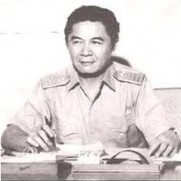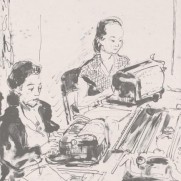07 Apr 2014
- Piet Sanders – drawing by Henk Ngantung
- Henk Ngantung
- Typists at work in Linggadjati – drawing by Henk Ngantung
Today Mrs. Joty ter Kulve donated the historical drawings made by the Indonesian artist and former governor of Jakarta, Henk Ngantung, to the National Archives in The Hague.
Linggarjati is not only the name of a little village east of Jakarta in Indonesia, but also the name given to an agreement. The Linggadjati Agreement was a political accord concluded on 15 November 1946 by the Dutch administration and the unilaterally declared Republic of Indonesia. The Dutch side was represented by Lieutenant General Governor Hubertus van Mook, the Indonesian side by Prime Minister Sutan Sjahrir. Negotiations had begun in October 1946 and a ceasefire in Java and Sumatra was agreed to. Recognizing their still weakened position following World War II, the Netherlands were more prepared to negotiate with the Republic than they were later during the Indonesian National Revolution. According to the terms of the agreement, the Netherlands agreed to recognize Republican rule over Java, Sumatra and Madura. The Republic would become a constituent state of the United States of Indonesia, which would be established by 1 January 1949 at the latest and form a Netherlands-Indonesian Union together with the Netherlands, Suriname, and the Netherlands Antilles. The then Dutch Queen would remain official head of this Union.
On 25 March 1947 the Dutch House of Representatives ratified a ‘stripped down’ version of the treaty that was, however, not accepted by the Indonesians. Further disagreements rose over the implementation of the agreement. On 20 July 1947 the Dutch administration cancelled the accord and proceeded to commence military intervention in form of the Operatie Product, the first of two events known as ‘police actions’. After the agreements surrounding the Linggadjati Agreement broke down there was a prolonged period of diplomatic dispute and open conflict in Indonesia for much of 1947 between the Dutch and Indonesian authorities. The United Nations Security Council established a Committee of Good Offices, which led to the signing of the Renville Agreement in January 1948 on the USS Renville anchored off Jakarta. However the Linggadjati Agreement and the Renville Agreement were at best only partially successful. Disagreements and sharp military clashes between the Dutch and the Indonesia sides continued on throughout 1948 and into 1949.
During the negotiations in Linggadjati, the Indonesian artist Henk Ngantung (1921-1991) made drawings of the persons present. These drawings came to the possession of Prof. Mr. Piet Sanders (1912-2012), in later years a famous art collector. The jurist and key official Sanders accompanied Schermerhorn to Linggadjati. The lawyers Piet Sanders and Ivo Samkalden (future mayor of Amsterdam) negotiated in the background en conceptualized various proposals for the independence of Indonesia. In 1947 Sanders resigned from office in dissatisfaction with the war-minded policy of the Netherlands towards Indonesia.
Prof. Piet Sanders handed over these drawings to Mrs. Joty ter Kulve, who in turn decided to donate them to the National Archives on April 7, 2014. See further for the speech of Mrs. Joty ter Kulve.






